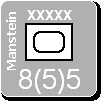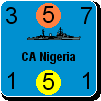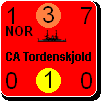Shannon V. OKeets
Posts: 22095
Joined: 5/19/2005
From: Honolulu, Hawaii
Status: offline

|
Originally, I was going to simply provide RAC (Rules as Coded) and a description of the each form in the game to communicate the sequence of play to the players. However, I have changed my mind. The sequence of play is simply too difficult to understand, even by experienced players, to pass over it lightly in the documentation (player's manual).
Therefore I have added another section to the player's manual, devoted solely to the sequence of play. I was hoping that this would contain just a few sentences on each phase and subphase of the game, but before I even got to the first phase (Lend Lease) I fely I needed to provide a lot of background material. Here is the start of Section 7 Sequence of Play. I expect to write the rest of it over the next 2 or 3 weeks.
=====
7.0 Sequence of Play
7.1 Phases for Setting Up a New Game
In order to understand the phases of the game associated with setting up units, you need to have an understanding of the various off-map pools that MWIF maintains. Every unit in the game is either on the map or in an off-map pool. Here is a overview of the off-map pools:
• Future Force Pool - Units that are unavailable until future years are placed in the future force pool. For example, at the start of the war, 1939, most units are in the future force pool. Historically, the quality and quantity of units engaged in combat increased over the course of the war. MWIF simulates this by making more (and better) units available to every country at the start of each year. During the January/February turn of each year, units are automatically moved from the future force pool to the force pool.
• Force Pool - The force pool contains all the units that are eligible to be built. During the production phase at the end of each turn, players can spend build points to build units from their force pool. The force pool is divided into over a hundred subsets, with each major power having its own force pool subsets. For example, the USA has separate force pools for armor, infantry, artillery, fighters, bombers, battleships, carriers, and so on. Each of the major powers has a comparable set of force pools. When players decide to build a unit, they designate the type, which sometimes means designating the number of build points (BP) as well. In particular, there are two separate force pools for fighters: those that cost 2 BPs and those that cost 3 BPs. When a major power spends 2 BPs to build a fighter, a unit is randomly selected from those in the major power’s F2 (2 BP fighters) force pool . Once a major power has spent BPs, the randomly selected units are moved from the force pool to the production pool.
• Production Pool - The production pool contains units that have been built, but have not yet arrived as reinforcements. It is subdivided into 6 sections: one for each of the 6 bi-month turns during a year. Some units arrive as reinforcements in the turn immediately following their construction. Others take longer. For instance, 2BP fighters take 2 turns (4 months) and 3BP fighters take 3turns (6 months). A 2BP fighter built in Jan/Feb arrives as a reinforcement at the start of the May/Jun turn (i.e., it is in the May/Jun section of the production pool) . Most naval units take 2 years to build (12 turns). They are build in two stages, typically taking 6 turns (1 year) to complete each stage. Roughly speaking, historically ships were built in two stages, with the hull and superstructure built the first year and the armaments and personnel added in the second year. In game terms, the second year includes the training period/shake out cruise for new ships. Players spend build points for taking naval units through each stage of construction. Naval units that complete their first stage of production go from the production pool to the construction pool. Naval units that complete their second stage of construction arrive as reinforcements.
• Construction Pool - This pool contains only naval units that have completed their first stage of construction. Units can sit in this pool indefinitely. Whenever the player decides to spend the build points for the second stage of construction, he gets to choose which of the units in the construction pool to build. This is one of the rare exceptions where the unit being built is not randomly selected.
• Repair Pool - Naval units damaged during combat go into the repair pool. If a player wants to repair a naval unit, he spends the necessary build points and then gets to select which unit gets repaired. This is another exception where the unit being built is not randomly selected. Repaired naval units go into the production pool.
• Reserve Pool - This pool contains a country’s reserve land units. When a major power goes to war with another major power, its reserves arrive immediately as reinforcements. When a minor country goes to war, its reserves arrive as reinforcements during the reinforcement phase of the next turn. Reserve units that are destroyed in combat go into the force pool and are treated just like any other unit.
• Air Reserve Pool - This pool contains air units that have been built, but not assigned pilots. If you do not choose the optional rule pilots, this pool will always be empty. However, when playing with pilots, air units and pilots are built separately. You could build 3 air units and 2 pilots. At the start of the reinforcement phase, you get to choose which air units receive pilots and are placed on the map. Any air units without pilots go into the air reserve pool and are available to receive pilots during the next reinforcement phase.
• Lend Lease Pool - This pool contains air unit markers. These are not actually units in the sense that they can be built. Instead, lend lease air unit markers are part of a set where only some of the units can be built. At the start of the game, the “source country” has one or more units in a set of units that can be built. All the other countries have merely air unit markers sitting in the lend lease pool. For example, the USA is the source country for Tomahawks and has 2 Tomahawk fighters in its force pool. If the USA decides to built an F2 fighter, one of those units may be randomly drawn. Meanwhile, in the lend lease pool, China has 2 Tomahawk markers, the CW has 1, France has 1, and the USSR has 1. None of the air unit markers in the lend-lease pool may be built. If China requests a Tomahawk to be lend-leased to it from the USA, and the USA grants that request, one of the USA Tomahawks would be moved to the lend lease pool and one of the Chinese Tomahawks would move into the Chinese force pool. Instead of there being 2 USA Tomahawks in the game, there would then be 1 USA Tomahawk and 1 Chinese Tomahawk. Note that though there are 7 Tomahawk markers in the game, only 2 Tomahawk units are ever eligible for being in the game (built or on the map).
• Setup Pool - This pool contains the units currently being placed on the map - being “set up”.
• Broken Down Pool - This pool contains corps/army and division sized land units. When a player breaks a corps/army sized unit into divisions, the corps/army sized unit is placed in the broken down pool. They are not available for production. If the player decides to reform divisions into a corps/army, he is restricted to choosing from among the corps units in the broken down pool. Divisions that are destroyed during combat go into the broken down pool. The player can choose to reform divisions in the broken down pool into corps/army sized units. Should he decide to do so, the corps/army unit goes into the force pool and the divisions are removed from the game.
• Transfer Pool - This pool is only used during the “half-map” scenarios: Fascist Tide and Day of Infamy. It contains naval units that are deployed “on the other side of the world”. For example, Fascist Tide only uses the European ‘half’ of the world, so when you are playing that scenario, the transfer pool contains naval units that are deployed in the Pacific and Indian Oceans. Those scenarios permit some movement of units between the map and the transfer pool. Indeed, some movements between the map and the transfer pool are mandatory.
• Conquered Pool - This pool contains units belonging to countries that have been conquered. They are kept separate since the might become available again if their home country is liberated.
• Internment Pool - This pool contains air units that have been interned. This happens very rarely and these units can return to combat under special circumstances.
• Scrapped Pool - This pool contains units of all types that the owner has voluntarily chosen to scrap. Scrapping units is a vital part of the game, since it enables you to remove obsolete (i.e., poor quality) units from your force pool, thereby improving the over quality of your force pool. The better the quality of the units in your force pool, the more likely you are to draw good units. If you do not scrap units, you may find yourself drawing a weak fighter built in 1937 instead of the spectacular new jet fighter from 1945.
• Removed Pool - This pool contains units that are not part of the game. For example, it contains all the divisional size units if you do not select the optional rule Divisions, or all the Light Cruisers if you do not select the optional rule Cruisers in Flames.
_____________________________
Steve
Perfection is an elusive goal.
|
 Printable Version
Printable Version















 New Messages
New Messages No New Messages
No New Messages Hot Topic w/ New Messages
Hot Topic w/ New Messages Hot Topic w/o New Messages
Hot Topic w/o New Messages Locked w/ New Messages
Locked w/ New Messages Locked w/o New Messages
Locked w/o New Messages Post New Thread
Post New Thread